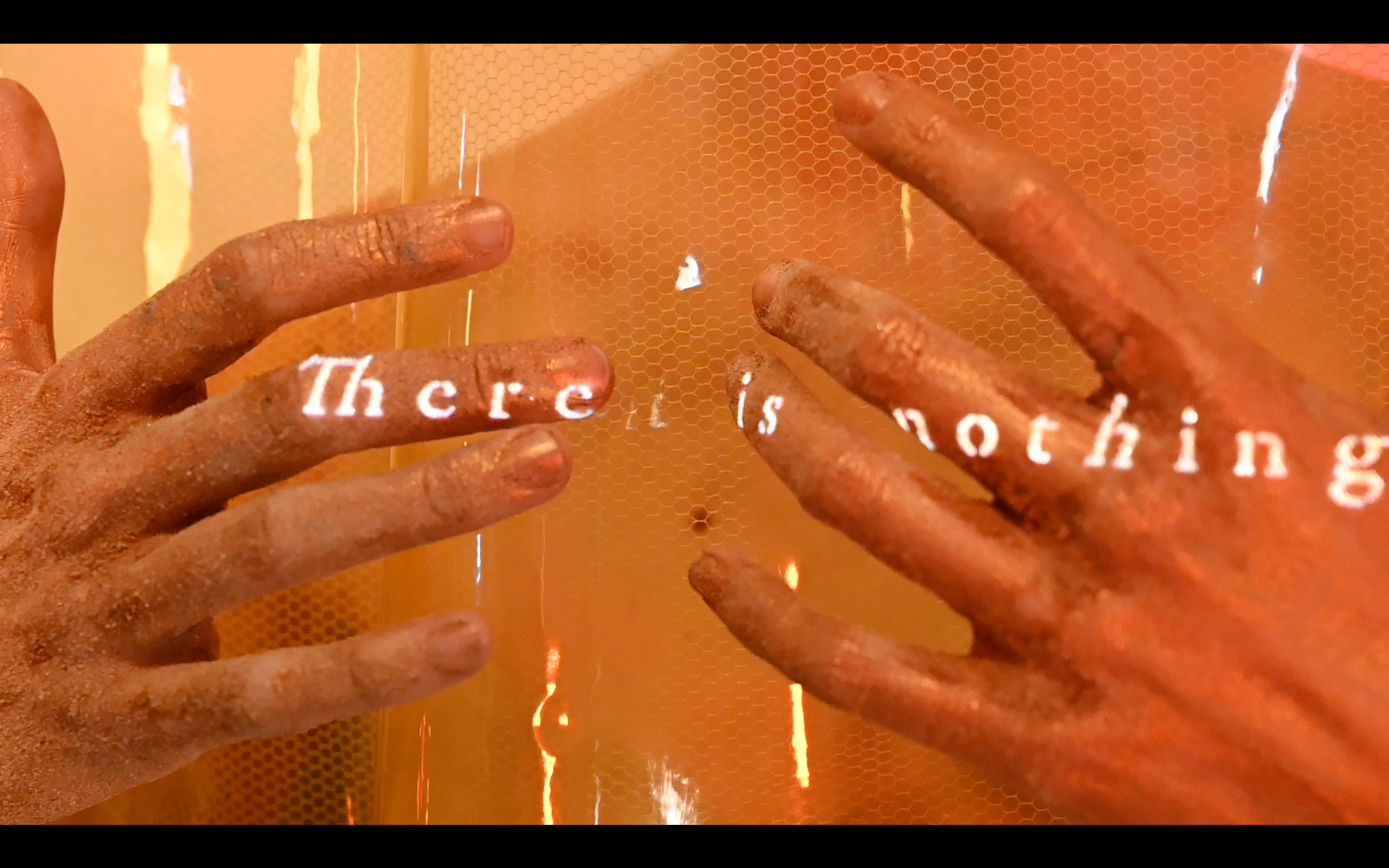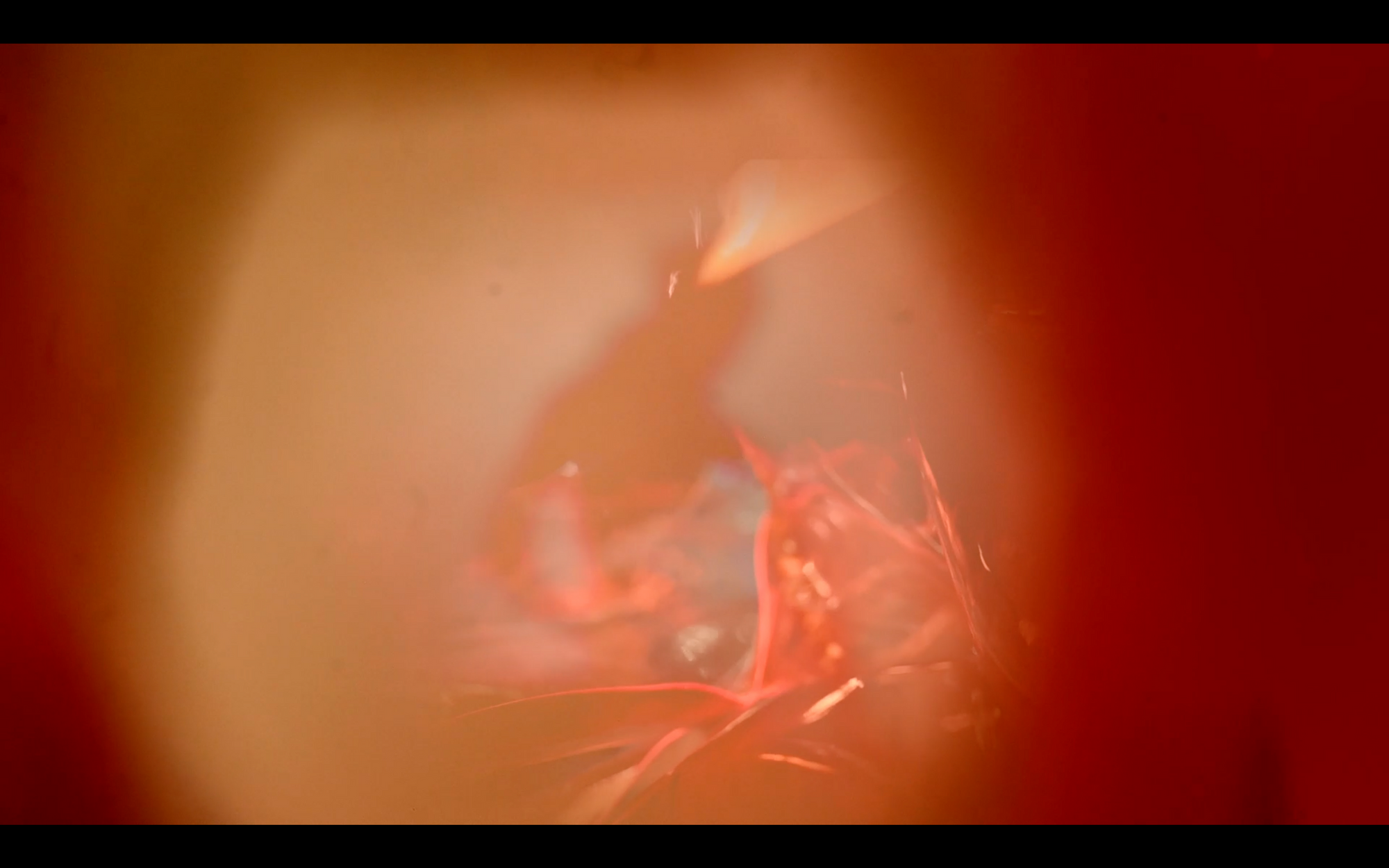Alive in the Energy of this Piece
Beneath the Surface is a performance video work-in-progress by Marisa Michelson and Miriam Parker, two co-fellows from National Sawdust’s season-long collaboration with the Center for Ballet and the Arts at NYU. The project was developed in residence at Pioneer Works and will be presented online by National Sawdust and Pioneer Works at 6 P.M. this evening.
In March 2021, during an onsite residency at Pioneer Works, Constellation Chor (Marisa Michelson) teamed up with multidisciplinary artist Miriam Parker to collaborate on an undetermined project that would bridge Constellation Chor’s ethereal vocal and body-based performance with Miriam Parker’s movement exploration and vivid imagery. Through their collaboration and experimentation with each other, they created Beneath the Surface, a visual and sonic document that explores process as source and “the visual and aural space between form and no-form, sound and no-sound, material and immaterial.”
After they completed the current iteration of the work, I joined Marisa and Miriam on a Zoom call to record their interpretation of this collaboration and how their process became their concept, to provide creative context for the virtual presentation of Beneath the Surface.

Beneath the surface was a project conceived by myself, collaborating with Marissa Michaelson. It is, in a way, like a brand new project. The format of collaboration between sound and video or sound and movement is very old, but the format of the necessity to present sound visually is very different. There is a call and a question that is needing to be answered from many musicians during this time of no longer having access to performance. Like how do we present sound without the body?
So this collaboration in many ways was a response to that call. How do we do that? I've worked in the realm of dance and video art, and those two elements come together for me through installation. So I definitely am resourcing both visual art, performance art and live music elements, and I've been doing that for a very long time. That's really where my practice is based. So it felt like I had a lot to say in response to that question about how we present the body and the sound when we don't really have a live body there.
So for me, a lot of the instigation of this collaboration was based on that question and then to speak a little bit further on what were the concepts that we were discussing and came together, where the meeting point conceptually was, it almost feels like Marisa barely had to explain what she was interested in. I was like, "Yeah, that's it, that's it." Because for me, I think all of the collaborations I'm involved with. I'm very lucky I've been working collaboratively for a really long time and it’s the basis of my practice, it is all about observing, practicing the phenomena of how something is created in the first place, which is something science still does not know.
We do not know, it is a mystery. So it's an infinite practice. I feel a lot of what we were honing in on is within the question of how creation happens. We were focusing on the point where two people meet and how is the forming of a new existence, whether it's creatively, sonically, visually, how does that really happen? And where does it happen? And an understanding and a common path that happens in the blurred lines.
For me, the question of blurred lines opened up an interest--how do you present something that's not fully formulated, because we're always... Even the word presentation itself, you're presenting something, a composition. It’s like, here's my composed idea. It's not like here's my decomposed composition. People can't find decomposed things because they're no longer things. My experience was to find a bit more comfort in those spaces between forms.

Talking about how our collaboration began, because as Miriam just described so much of where our interests aligned and has been in the act of forming something itself and the act of how do we come together, like how do we come together to form a relationship? And what is the kind of alchemy that happens between people and how do we meet? Where do we meet? Not only in our kind of physical presence meeting; where do our energies meet, where do our interests meet and what's going to happen out of that meeting? And that has been such a critical part of the content of this project that we've been making, and the process too. It's certainly something that I was initially most excited about.
So our collaboration happened, because I got this opportunity with Sawdust. They were asking about creating a piece and collaborating with a video artist, a videographer to create, to make something that I do normally with Constellation Core, my ensemble, and to put that into a digital form. That was very new for us. It's not something we do, and the other parameter was that it was a project engaging music and movement, choreography, and composition, and all of those elements came together at the same exact moment that I happen to be studying Buddhism in a community that Miriam is a part of and teaches meditation within.
So I got to know Miriam a little bit and looked up her work and became really, really overwhelmed by her work that I saw online and wanted to meet Miriam, generally, and talk about art and the intersection of art and spiritual practice. Then, specifically, this opportunity came and it was supposed to involve movement and video, which is what Miriam does. So I reached out to Miriam to talk about creating something together and what it could be like? What would our collaboration be like? Who will take on what role was kind of an open question at first. What are we both interested in? How do we honor our personal practices that we've been developing intensely for years? Honor each other's practices as individual practices and also find those open spaces and find those transparent spaces where we meet and that in and of itself? That process is also, incidentally, what we're both interested in content wise. Which is how do things form out of no form, and what are those spaces in between form and no form?
Musically, I've been really, really interested in the space between no voice and voice and all of the kinds of possibilities, not only in breathing and the sound of breathing and the sound of just making tones as opposed to singing melodies, but also in the act of singing itself. As close as possible, a way to sing with such little effort in the body that it's almost like the body is not doing anything, but sound is still coming.
So something that I work on in my own practice and with Constellation Core is really removing that barrier between - I'm here and now I'm singing and creating this singing even when I'm silent and still, and the first step in manifesting actual tone is imagining and hearing that tone and hearing that music and in that act of hearing our bodies are already starting to respond to what we hear in our minds and starting to move into--physiologically even--into a space where it's possible to create sound.
So the stronger the imagination of the music, the more the body is already ready to make it. How can we pay attention to that space and pay attention to what's happening when we imagine music and pay attention to how we're holding our bodies in those moments, when we're imagining music to give that space itself so much more weight.

All the content inspiration for your collaboration is literally based on just the idea of collaborating with each other. So you're constantly in this feedback loop of inspiring each other and working with each other, and then formulating that into the piece of art that you're working on. I'm curious about the nature of the work in progress, too, and the idea of presenting it as that. Is that because there's a finite end that you have yet to reach, or is it because the idea of this project is that it's ongoing and eternal in a way and it's going to map your collaboration infinitely?
I like that.
Yeah.
I'm liking more and more “in progress,” because my mind feels very attracted to the question of a concise thesis that is like: “this is what I'm doing, here you go.” I'm much more interested in pulling my own sharing of art-making as something that is a practice that must be attended to all the time. So ethical or conceptual statements that I make as an artist are not just billboards of “this is what I believe in,” “this is what I'm questioning,” but I actually try to create some sort of mechanism in which it questions me.
So like, can I create a machine? Can I create an installation or a project that my body and mind is placed into and works that concept upon me? Like if I'm questioning dark matter, if I'm questioning how things emerge, then I want to see if I can actually apply that question within myself on as many layers as possible. It's more of a curiosity to create machinery or installation or a dance move of rays that draw my mind to pay attention to things that I normally don't.
Because left to my own devices, I will continually just see the world as normal. I will continue to see Justin Frye and Marissa Michelson out there separate from me, because that's how my mind is seeing you. Honestly, I don't know what you're thinking. So if I'm going to put out a thesis that I'm connected to you, I cannot fool myself and think that I can just do it once and be like, "Yep, we're connected, done, check." It's something I have to continually practice. In a way that's maybe where the consistency of a meditation practice or something that I'm constantly moving my mind through. Like, I see my artwork kind of like a washboard that I constantly have to move my mind through. If not, it just gets soiled with crazy shit.
In the work itself, because each of our individual practices are so strong and clear in a way, specific, detailed, and we've been, each of us, working in an embodied way in our own practices and interests for so long, it's also interesting to note that it's not like the final thing that we're creating is something that was just arising in the moment, in the moment. The final stuff is really... you can see Miriam's work and the connection to all of Miriam's other work and what Miriam has been interested in creating, what Miriam's style is, and you can certainly hear that loud and clear in my music and like, what is my style? What kind of harmonies do I like? What kinds of layers am I interested in?
On a technical level, actually, it turned out that both of us work with layers and layering. Miriam layers video, and I layer voices. That was an interesting kind of way that we came together. Somehow, there's this belief that I think Miriam and I both have that the ethics of the process matters and that it will be somehow felt in the art that we create, it will be perceived or somehow felt or somehow present, even though the work itself is formed. There's something strong there that is Miriam's and Marissa's. That's somehow how we're approaching all of this, how we're talking about it together, how we're meeting each other is also alive in the energy of the piece.
Tune in at 6 P.M. to see the premiere of Beneath the Surface.
Subscribe to Broadcast